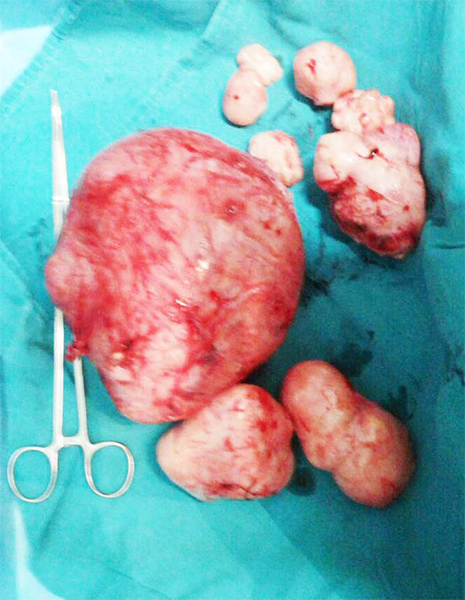Understanding Fibroids
Fibroids are muscles or tissues in the uterus that gather to form lumps (swellings) in various sizes, they can be as small as a coin or as big as a pumpkin. In addition, such swellings can be located in various places in the uterus.
Fibroids affect mostly blacks and the specific cause cannot be explained but, have been linked to genetic causes. That’s why they are common in African women and a common cause of illness. Some years ago, a woman came to my clinic with a big stomach, she knew she was pregnant and her friends also congratulated her upon her pregnancy.
However, the symptoms that come with pregnancy were absent and she got confused until she consulted me. I discovered that she wasn’t going to deliver but rather had a big fibroid that was about 5Kgs when I removed it.
Presentation and symptoms
Heavy menstrual flow the commonest symptom of fibroids is heavy periods. A normal menstrual loss per cycle/month in a woman is less than 100mls (10-20 tea spoons) of blood. This means a woman may use 3-4 sanitary pads for 2-3 days and she is dry. When it becomes heavy, the number of sanitary pads starts increasing. Once a woman starts using 2-4 packets (20-40 pads per month/ cycle,(small 500mls mineral water bottle ) then this is excessive bleeding and needs medical attention. A similar case is presented in the Bible, Mark 5:25-34. The woman with an issue of blood who had bled for 12 years and no physician had successfully fixed her condition. I can’t be sure whether this woman had fibroids, but, I can only speculate that she had a big fibroid that was responsible for her heavy bleeding. !!
A big lump
In another incidence, a lady aged 35 who had been married for nine years and reported heavy periods consulted me. I examined her and found that her uterus was so big and most people thought that she was about eight months pregnant. She had been to several doctors and they had discovered that she was anaemic due to heavy bleeding. The doctors she had consulted earlier had recommended a radical surgery that required the removal of her uterus because the fibroids were many and scattered all-over her uterus. She objected because for nine years she never had a child and removing her uterus would seal her fate of childlessness. I transfused blood before the surgery and removed the fibroids without necessarily removing the uterus. This surgery lasted four and a half hours and we extracted 120 fibroids in total. Honestly! I had never removed such a number of fibroids from a single patient, because the maximum I had ever removed was 47 and 50 respectively.
Coincidental findings on ultrasound
These days, ultrasound examination is very common. Some people now they have these small scans in their homes and they can do self-examination on themselves. Once fibroids are found, then a cycle of panic starts and to make it worse, many request for surgery when actually it is not necessary. This might lead to more complications in future and surgery is done which results in fertility and big ugly scars on the tummy! So if you find fibroids and you have no symptoms, please do not rush. Please wait and complete your family before rushing for the surgeon’s knife. The surgeon will even sharpen his knife very fast and you hand him your hard earned $s!! Please pause first and consult the right people.
Pain
Pain is not a common feature of fibroids in somebody who is not pregnant. Pain is usually occurring in 30% of women who are pregnant with fibroids. Most women who have fibroids which are small, do not get pain. A big fibroid due to pressure on back nerves can cause backache and if so, once it is removed, these symptoms will disappear.
Urinary symptoms
Frequency of micturition (going for a short call very frequently) may occur if fibroids are big and pressing on the urinary bladder. This is a good reason to have this fibroid removed. It means it is significantly big
Infertility
Unless fibroids are very big and one has had prior surgery, they do not usually cause this problem. Surgery of fibroids, in my experience will cause damage to fallopian tubes in 75% of cases. If after fibroids surgery, a woman is not becoming pregnant within six months following the procedure, go for IVF. Nothing else will help you. Start saving for this. This means that even if your tubes appear patent on HSG x-ray, they are made non-functional due to damage caused by fibroid fluids, which occur during surgery-especially open surgery. Laparoscopic fibroid surgery is a better way of operating provided the number of fibroids in the uterus is less than four. More than this open surgery is quicker and safer.
Cancer
The good news is that fibroids are not cancerous. It is very rare if this happened. If this was true, we will be seeing many women on daily basis dying from this disease. In my practice of gynaecology I have seen one case in a period of 35 years. This was also a different form of cancer.
Miscarriages
They usually do not cause this. However if a fibroid is in a wrong place, like within the inside of the uterus (sub mucosal) and you have had two to three miscarriages, or failed IVF treatment, then this should be removed irrespective of its size.
Fibroids are categorised depending on their location.
What is the prevalence of fibroids?
The reported incidence of fibroids in women of reproductive age is between 70-80% during their reproductive life (15-49 years). Estimates indicate that fibroids affect eight in ten black women and less in Caucasian (white) women. These non-cancerous tumours can only cause infertility if they affect the intrauterine cavity that supports child development.
After analysing 200 case files of women who had fibroids between 2011 and 2016, and where successfully treated at Women’s Hospital International and Fertility Centre (WHIFC) in Kampala Uganda. The findings indicated that fibroids were commonest amongst women in the age groups of 35-39 years and 40-44 years respectively. The reason why fibroids are at 2% between 20-24 years and after 50 years, is because during those years the levels of oestrogen and progesterone are low.
Treatment
Treatment can be as follows Asymptomatic fibroids Just have a good talk with your gynecologist and present facts and not myths. If fibroids are not causing any problem, and are just coincidental findings, there is nothing to worry. Just need regular checking say every six to twelve months and see how they are progressing. It is important that high intake of estrogen containing substances is reduced. As motioned in this article, weight loss and eating good and balanced diet with plenty of vegetables and fruits will deter rapid growth of fibroids. Do not rush for surgery as explained above
Symptomatic fibroids
Oral-Medicines
These can be used to control heavy periods. For example, if you are about to do exams, or going for holidays, or attending long meetings, there specific drugs that be used during this time either to defer menstruation or to lessen the severity of bleeding. Drugs like Tranaxamic and Mefanamic acid are quite useful for this sort of short-term remedy Injectable medicines There are strong injectable medicines that can also help in the following scenarios
Near menopause:
If a woman has completed her family and very close to menopause, for example aged 42 and o;ver, we can institute these injectable to push her into menopause, thus rendering her amennorhic (no periods)
Anemia:
If somebody is anemic because of fibroids and has to undergo surgery it is very recommendable to use these drugs, to stop menstruation before surgery is done. It will help her anemia to be sorted out and she will be very strong during surgery and also there will be very minimal bleeding during the surgical procedure
Herbal medication.
They are certain herbs of course that can also help. However the problem of these herbs is that the dose is not regulated, and can actually cause more damage than good. They should only be used for very short periods. Some of them may even cause the fibroids to grow bigger because of natural occurring estrogen (food for fibroids) in some of these plants.
Hormonal Therapies
These are birth control pills used to control heavy bleeding brought about by the presence of the uterine fibroids. However, such therapies may not necessarily reduce their size.
Surgery
After detecting the presence of fibroids, surgery may be recommended depending on the size, location and severity and the danger they may are likely to cause. Other methods of surgeries include; abdominal surgery, surgery through the vagina, and a key hole surgery (laparoscopy). In addition, doctors may see it necessary to remove the entire uterus if it is damaged beyond repair. Other treatments Modern treatments of fibroids practised by advanced hospitals include; blocking the blood supply to a fibroid hence causing it to shrink (Embolisation). Another modern method involves the removal of the lining of the uterus( endometrial resection) or killing the fibroids using energy such as microwaves or heat.
Usage of Minera IUCD
This is a special IUCD coil impregnated with hormones. It is extremely useful and can cut down 75-90% need for surgery of those women who have completed their family and their fibroids are very few but with severe symptoms like heavy periods.
Beautiful women
They used to say, fibroids affects only beautiful women. I may tend to believe this over the years of practice, especially as my wife is also beautiful and had fibroids but we had children without any need for surgery. This might be of great comfort to some men whose wives have fibroids. A true joke!!
Dr Edward Tamale Sali
FRCS; FRCOG (uk)
Obstetrician and gynaecologist
drsali@hotmail.com
Founder and Director of Women’s Hospital International and Fertility Centre in Bukoto, Kampala.






















